The Next of Kin Memorial Plaque & Scroll
In October 1916 the British Government set up a committee regarding the idea for a commemorative memorial plaque that could be given to the relatives of men and women whose deaths were attributable to the Great War of 1914-1918.
- Design of a Memorial Plaque
- Response to the Competition
- A Memorial Scroll
- Winner of the Plaque Design
- Production of the Memorial Plaque and Scroll
- Distribution of the Plaque and Scroll
- Related Topics
Design of a Memorial Plaque
Members of the committee were selected from the House of Commons, the House of Lords and some government departments. The Chairman of the committee was Sir Reginald Brade, MBE, JP. He was the Secretary of the War Office at the time.
It was agreed that the memorial to be issued to the next of kin would be produced and paid for by the British Government in some form of metal plaque. It was agreed that it would take the form of a small bronze plaque. In August 1917 the committee set up a competition for anyone to enter who could put forward a suitable design for a bronze plaque to record the name of a fallen British or Dominion Forces serviceman or woman. The top few selected entries would be offered prizes of up to £500. The winner of the first prize winner would have their design cast in bronze and subsequently issued to the hundreds of thousands of families who had lost loved ones in the Navy and in the Army. At this time in 1917 the Royal Air Force had not yet been formed as a separate Service in the British military forces. From 1st April 1918 it would be formed as a separate Service.
Rules of the Memorial Plaque Competition
The plaque competition was open to all British-born subjects. Rules and application forms were provided by the Admiralty and the War Office.
Judging the Designs
The judging of the designs entered into the competition was carried out by the main committee and a sub-committee comprising the Directors of London's National Gallery, the Director of the Victoria &and Albert Museum in Kensington, and the Keeper of the Department of Coins and Medals at the Victoria & Albert Museum.
Instructions for the Memorial Plaque Competition
Instructions for each design entry were published in The Times on 13th August 1917. The plaque design could be either round or rectangular and the size specifications were to be:
- approximately 18 square inches
- circular design: the diameter was to be 4 1/2 inches (equivalent to 11.43cm)
- rectangular: 5 inches x 3 3/5 inches (equivalent to 12.7cm x 8.8cm)
relief models were to be provided as an entry in wax or plaster and the chosen design was to be cast and it would have a precision finish.
Another two stipulations regarding the design was that a symbolic figure was to be incorporated into the finished design and also the plaque had to carry an inscription, as agreed by the committee. The inscription was to read:
“He died for Freedom and Honour”
If the plaque was submitted as a circular design the inscription was to be incorporated in a margin around the diameter. If the plaque was to be rectangular in design the inscription was to be positioned at the base of the plaque.
Each plaque design was also to have space for the name, initials and military unit of the deceased serviceman to be commemorated.
The closing date for entries was origianlly set at 1st November 1917. Entries for the plaque models were not to be submitted with a name on them. Instead they were to be marked with a pseudonym or a motto, which was correspondingly put onto a sealed envelope which would contain the competitor's name and contact details. Each entry was to be sent to the Director of the National Gallery.
When the winner was chosen that plaque design would be the property of the British Government. The name of the winning artist would be incorporated into the finished design of the plaque.
Response to the Competition
There was such alot of interest from people wanting to submit designs for the memorial plaque that the closing date was extended by a few weeks to 31st December 1917 so that servicemen on active service overseas would have an opportunity to submit a design.
There were more than 800 entries to the competition from within the United Kingdom, from countries in the British Empire and from the theatres of war.
A Memorial Scroll
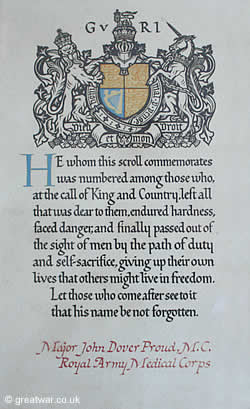
|
In October 1917 it was announced in The Times newspaper that the committee had decided also to issue a commemorative scroll to the next of kin in addition to the bronze plaque. The scroll would be printed on high quality paper, size 11 x 7 inches (27cm x 17cm).
By January 1918 the wording on the scroll was being discussed. The committee found the choice of words very difficult and asked for advice from numerous well-known writers. Among those approached for suggestions was Rudyard Kipling, whose only son John was missing in action, believed killed, at the Battle of Loos in late September 1915.
However, even with this help the committee couldn't make a decision on the words. Dr Montague Rhodes James, Provost of King's College Cambridge, was then asked if he would write a draft for the wording. With a few changes the Provost's text was accepted by the committee. King George V asked if the King could be included in the scroll wording and the draft text of “at the bidding of their country” was changed to “at the call of King and Country”.
The accepted wording agreed by the committee was:
“He whom this scroll commemorates
was numbered among those who,
at the call of King and Country, left all that was dear to them
endured hardness, faced danger, and finally passed out of the sight of men by the path of duty
and self sacrifice, giving up their own lives that others might live in freedom.
Let those who come after see to it
that his name be not forgotten.”
The text was to be printed in calligraphic script beneath the Royal Crest followed by the name of the commemorated serviceman giving his rank, name and regiment this time individually written in calligraphic script.
Winner of the Plaque Design
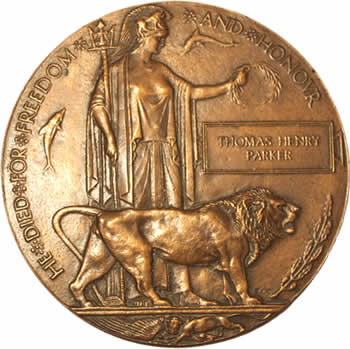
|
On 20th March 1918 the results of the competition were announced in The Times newspaper. This was the day before the German Army launched a massive surprise attack on several miles of the British Front on the Somme battlefield in France. By the end of the following day, 21st there were several thousand more British casualties caused by this attack, whose names would be added to the list of those to be commemorated by this memorial plaque.
The names of seven prize winning entries were announced, together with names for 19 highly commended entries. All but one of the seven prize winning entries were circular in dedesign. The designs were made available for the public to see in an exhibition at the Victoria & Albert Museum, Kensington.
Prize Winners
The sum of £250 was awarded for two entries submitted under the pseudonym of “Pyramus”. The overall winning design was chosen from these two entries. They were by Mr Edward Carter Preston (1894-1965), founder of the Sandon Studies Society, Liberty Buildings, School Lane in Liverpool.
Mr E Carter Preston was also responsible in the same year for medal designs for the newly formed Royal Air Force's gallantry medals dating from June 1918, these being the silver Air Force Cross, the silver Distinguished Flying Cross, the silver Air Force Medal, and the Distinguished Flying Medal. E Carter Preston was a painter, sculptor and medallist.
The sum of £100 was awarded to two entries under the pseudonym “Woolie”, which had been submitted by Mr Charles Wheeler of Justice Well Studios, Chelsea in London.
A prize of £50 was awarded to each of three further entries to “Sculpengro” (two designs by Mr William McMillan), “Weary” (a design by Sapper G D Macdougall) and “Zero” (a design by Miss A F Whiteside).
Publication of the Winning Design
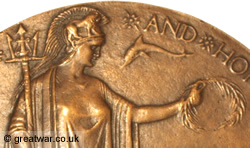
|
The winning design by Mr E Carter Preston was described and shown to the public in The Times newspaper three days later, on 23rd March 1918. The design incorporated the figure of Britannia. She is facing to her left and holding a laurel wreath in her left hand over the box where the commemorated serviceman's name was to be placed. In her right hand she is holding a trident. In representation of Britain's sea power there are two dolphins each facing Britannia on her left and right sides.
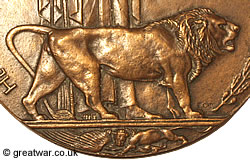
|
A lion is standing in front of Britannia at her feet, also facing to the left with a menacing growl. As specified by the committee, the words “He died for freedom and honour” are written around the margin of the circular plaque. A very small lion, with his head facing to the right can be seen underneath the larger lion's feet, biting into a winged creature representing the German Imperial eagle.
Interestingly there was a response to the design from the zoo at Clifton, Bristol, whereby a letter was written to The Times to say that the lion was not very life-like, looked a bit feeble as it was too small in scale compared to Britannia.
Production of the Memorial Plaque and Scroll
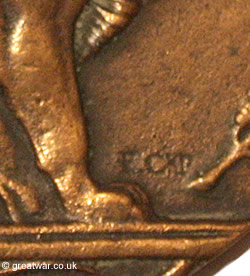
|
The production of the plaque and scroll did not start until late in the autumn of 1918 because of problems with setting up the manufacture of the bronze plaques and the high quality printed scrolls. The supply of the metal and the paper were difficult to obtain in wartime. However, in the first month after the war was over the first plaques began to be produced in December 1918 at the Government's Memorial Plaque Factory in Acton at 54-56 Church Road, London W3.
A specimen of the plaque is held in the collection at the Victoria & Albert museum(1). The space where the serviceman's name would normally appear instead carries the words:
VICTORIA AND ALBERT MUSEUM SPECIMEN MCMXIX
The manufacturing of the plaques at the Acton factory got into difficulty and the production was moved to the Woolwich Arsenal munitions factory in south London. The plaques produced at Woolwich have a capital letter W with a line across the centre of the W, forming a W and an A for the Woolwich Arsenal, set inside a circle on the otherwise blank reverse of the plaque.
On some plaques the first letter “H” of the “HE DIED...” phrase around the margin of the plaque was made narrower. The designer, E Carter Preston, changed this part of the plaque design to allow for an “S” to be inserted for female recipients. After 1500 memorial plaques were struck with “SHE” (some 600 women's families were actually in receipt of these plaques) the mould was changed to remove the “S” but the narrower “H” was left on the mould. The original wider “H” on the original design was produced from the original mould design for plaques mostly issued to Army personnel.
The finished cast of the plaque bears the letters E CR P near the lion's right paw, this being the initials of Mr E Carter Preston, the artist and designer of the plaque.
Some plaques produced in the production process include a stamped batch number in front of the lion's rear left paw.
The production of the memorial scrolls was begun from January 1919, being printed from a wood block by artists at the London County Council Central School of Arts and Crafts.
Distribution of the Plaque and Scroll
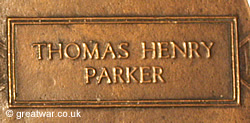
|
The relative named as the “next of kin” in a serviceman's Service Record was sent a form to complete as a statement to confirm all the living next of kin of that serviceman and the person to whom the plaque and scroll should be sent.
Army Form W.5080
From 1919 into the 1920s the British Army records offices sent out forms to the named next of kin in a deceased soldier's Service Record. This form was called Army Form W.5080. On one side of the form there was the handwritten address of the next of kin to whom it had been sent, a prepaid printed return address and printed instructions on how to fold the form and seal it for its return. Also on this side of the form the following text was printed to the addressee:
“In order that I may be enabled to dispose of the plaque and scroll in commemoration of the soldier named overleaf in accordance with ths wishes of His Majesty the King, I have to request that the requisite information regarding the soldier's relatives now living may be furnished on the form overleaf in strict accordance with the instructions printed thereon.
The declaration thereon should be signed in your own handwriting and the form should be returned to me when certified by a Minister or Magistrate.”
On the reverse of the Army Form W.5080 the officer in charge of records had completed the soldier's details at the top of the form. The next of kin then had to complete details for widow, children, father, mother, full blood and half blood brothers and sisters, sign and date the form. The form was then to be counter-signed and dated by a minister or magistrate as a declaration of the true statement of the information provided.
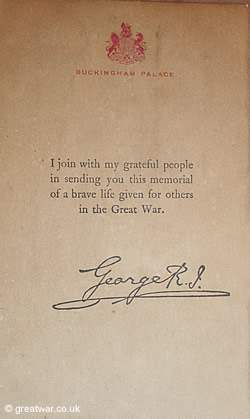
|
From 1919 and for several years after the end of the Great War there were over 1,000,000 plaques and scrolls sent to next of kin in commmemoration of their soldiers, sailors, airmen and a few hundred women who died as a direct consequence attributable to service in the Great War. All those who died between 4th August 1914 and 30th April 1919 whilst in military service in the battlegrounds of the theatres of war and in the Dominions, as a result of sickness, suicide or accidents in the Home Establishments, or as a result of wounds incurred during their time in military service were commemorated on a plaque and a scroll.
The next of kin of the 306 British and Commonwealth military personnel who were executed following a Court Martial did not receive a memorial plaque.
The circular shape and coin-like appearance soon contributed to the nickname of this memorial plaque becoming widely known as the “Dead Man's Penny”, the “Death Penny”, “Death Plaque” or “Widow's Penny”.
Approximately 600 memorial plaques were issued to the next of kin of women who died as a direct consequence of their involvement in the Great War. In these cases the motto on the plaques was amended to “She died for freedom and honour”.
Packaging
The plaque was sent out to relatives in an “On His Majesty's Service” white envelope with a printed “Official Paid” stamp. Inside this outer envelope there was another white envelope with the Royal Crest embossed on the reverse enclosing a letter with a copy of King George V's signature. The letter was written as follows:
Buckingham Palace
I join my grateful people in
sending you this memorial of a
brave life given for others in the Great War.George R.I.
Inside the outer envelope a cardboard envelope protected the bronze plaque.
Separately the scroll was sent to relatives inside a cardboard tube 7 1/4 inches (18.5cm) long. Due to the vast numbers of the plaques and scrolls being produced and sent out in some cases the scroll and plaque were received by the families some significant time apart.
Records of Distribution of Plaques and Scrolls
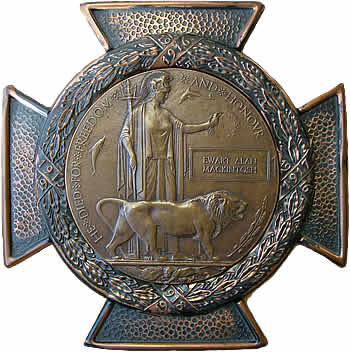
|
The records from the factories producing the plaques no longer exist. Army Records for the distribution of plaques and scrolls to named British soldiers do not appear to exist either, other than where the completed Army Forms W.5080 by the next of kin can be found in the surviving WW1 British soldiers' Service Records.
The Service Records of Australian, Canadian and New Zealand servicemen and women do exist intact. Where the serviceman or woman was a casualty and eligible for a Memorial Plaque and Scroll the set of records contains a sheet with a reference number and the date of despatch to the next of kin of the memorial plaque and scroll.
In some cases family historians cannot trace the location of the memorial plaque in their family and sadly it may likely be that the orginal plaque and scroll were received but over time have been lost or destroyed. It is not possible to request a replacement.
Whilst the Memorial Plaques may often be found, finding a set of a Next of Kin Memorial Plaque complete with its outer envelope, inner card envelope and covering letter with a memorial scroll commemorating the same casualty of war is rare.
In some cases families mounted the bronze plaque in an individually designed frame or mount. The example illustrated here is the Next of Kin Memorial Plaque for Lieutenant Ewart Alan Mackintosh, killed in action whilst serving with the 5th Seaforth Highlanders in September 1917.
Related Topics
British Army WW1 Service Records, 1914-1920 (Soldiers)
For information about the surviving Service Records for British Army soldiers go to our page at:
British Army WW1 Service Records, 1914-1920 (Soldiers)
British Army WW1 Service Records, 1914-1920 (Officers)
For information about the surviving Service Records for British Army officers go to our page at:
British Army WW1 Service Records, 1914-1920 (Officers)
Records of WW1 Dead
To find out how to go about searching for the grave or place of commemoration of a casualty of the First World War see our page at:
Records for the War Dead of WW1
Acknowledgements and Footnotes
1 http://collections.vam.ac.uk/item/O111667/medal-next-of-kin-memorial-plaque/
2 Photograph courtesy of Barry Jenkins.
Imperial War Museum, Victoria & Albert Museum, National Archives.
